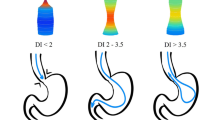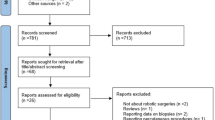Abstract
Background
Thermal injury and unexpected bleeding caused by ultrasonic scalpels can lead to fatal complications in laparoscopic gastrectomy (LG), such as postoperative pancreatic fistulas (POPF). In this study, we developed the “Hit and Away” protocol for optimal usage of the ultrasonic scalpel, which in essence involves dividing tissues and vessels in batches using the tip of the scalpel to control tissue temperature.
Methods
To assess the effectiveness of the technique, the surface temperature of the mesocolon of female swine after ultrasonic scalpel activations was measured, and tissue samples were collected to evaluate microscopic thermal injury to the pancreas. In parallel, we retrospectively surveyed 216 patients who had undergone LG before or after the introduction of this technique and assessed the ability of this technique to reduce POPF.
Results
The tissue temperature of the swine mesocolon reached 43 °C, a temperature at which adipose tissue melted but fibrous tissue, including vessels, remained intact. The temperature returned to baseline within 3 s of turning off the ultrasonic scalpel, demonstrating the advantage of using ultrasonic scalpel in a pulsatile manner. Tissue samples from the pancreas demonstrated that the extent of thermal injury post-procedure was limited to the capsule of the pancreas. Moreover, with respect to the clinical outcomes before and after the introduction of this technique, POPF incidence decreased significantly from 7.8 to 1.0 % (p = 0.021).
Conclusion
The “Hit and Away” technique can reduce blood loss and thermal injury to the pancreas and help to ensure the safety of lymph node dissection in LG.




Similar content being viewed by others
References
Obama K, Okabe H, Hosogi H, Tanaka E, Itami A, Sakai Y (2011) Feasibility of laparoscopic gastrectomy with radical lymph node dissection for gastric cancer: from a viewpoint of pancreas-related complications. Surgery 149(1):15–21. doi:10.1016/j.surg.2010.04.014
Jiang X, Hiki N, Nunobe S, Kumagai K, Nohara K, Sano T, Yamaguchi T (2012) Postoperative pancreatic fistula and the risk factors of laparoscopy-assisted distal gastrectomy for early gastric cancer. Ann Surg Oncol 19(1):115–121. doi:10.1245/s10434-011-1893-y
Fukunaga T, Hiki N, Tokunaga M, Nohara K, Akashi Y, Katayama H, Yoshiba H, Yamada K, Ohyama S, Yamaguchi T (2009) Left-sided approach for suprapancreatic lymph node dissection in laparoscopy-assisted distal gastrectomy without duodenal transection. Gastric Cancer 12(2):106–112. doi:10.1007/s10120-009-0508-9
Hiki N, Fukunaga T, Yamaguchi T, Nunobe S, Tokunaga M, Ohyama S, Seto Y, Yoshiba H, Nohara K, Inoue H, Muto T (2008) The benefits of standardizing the operative procedure for the assistant in laparoscopy-assisted gastrectomy for gastric cancer. Langenbecks Arch Surg 393(6):963–971. doi:10.1007/s00423-008-0374-7
Bassi C, Dervenis C, Butturini G, Fingerhut A, Yeo C, Izbicki J, Neoptolemos J, Sarr M, Traverso W, Buchler M (2005) Postoperative pancreatic fistula: an international study group (ISGPF) definition. Surgery 138(1):8–13. doi:10.1016/j.surg.2005.05.001
Dindo D, Demartines N, Clavien PA (2004) Classification of surgical complications: a new proposal with evaluation in a cohort of 6336 patients and results of a survey. Ann Surg 240(2):205–213
Morrison JE Jr, Jacobs VR (2007) Rupture of the spleen with the Harmonic scalpel: case report of an unexplained complication. JSLS 11(2):268–271
Pogorelic Z, Perko Z, Druzijanic N, Tomic S, Mrklic I (2009) How to prevent lateral thermal damage to tissue using the Harmonic scalpel: experimental study on pig small intestine and abdominal wall. Eur Surg Res 43(2):235–240. doi:10.1159/000226219
Vetere PF, Apostolis C (2010) Ureteral injury due to a Harmonic scalpel during laparoscopic salpingo-oophorectomy. JSLS 14(1):115–119. doi:10.4293/108680810X12674612014987
Lakshmanan A, Ravichandran P, Jeswanth S, Sukumar R (2012) Bleeding complication after pancreatic surgery: role of Harmonic scalpel. Indian J Surg 75(1):436–438. doi:10.1007/s12262-012-0758-3
Sutton PA, Awad S, Perkins AC, Lobo DN (2010) Comparison of lateral thermal spread using monopolar and bipolar diathermy, the Harmonic scalpel and the Ligasure. Br J Surg 97(3):428–433. doi:10.1002/bjs.6901
Disclosures
Tomoyuki Irino, Naoki Hiki, Manabu Ohashi, Souya Nunobe, Takeshi Sano, and Toshiharu Yamaguchi declare no financial interests and conflicts of interest.
Human and Animal Rights
The swine used in the animal experiment were kindly provided by Johnson & Johnson K.K. (Tokyo, Japan).
Author information
Authors and Affiliations
Corresponding author
Rights and permissions
About this article
Cite this article
Irino, T., Hiki, N., Ohashi, M. et al. The Hit and Away technique: optimal usage of the ultrasonic scalpel in laparoscopic gastrectomy. Surg Endosc 30, 245–250 (2016). https://doi.org/10.1007/s00464-015-4195-9
Received:
Accepted:
Published:
Issue Date:
DOI: https://doi.org/10.1007/s00464-015-4195-9




